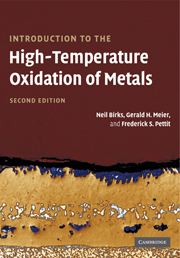Book contents
- Frontmatter
- Contents
- Acknowledgements
- Preface
- Introduction
- 1 Methods of investigation
- 2 Thermodynamic fundamentals
- 3 Mechanisms of oxidation
- 4 Oxidation of pure metals
- 5 Oxidation of alloys
- 6 Oxidation in oxidants other than oxygen
- 7 Reactions of metals in mixed environments
- 8 Hot corrosion
- 9 Erosion–corrosion of metals in oxidizing atmospheres
- 10 Protective coatings
- 11 Atmosphere control for the protection of metals during production processes
- Appendix A Solution to Fick's second law for a semi-infinite solid
- Appendix B Rigorous derivation of the kinetics of internal oxidation
- Appendix C Effects of impurities on oxide defect structures
- Index
Introduction
Published online by Cambridge University Press: 05 June 2012
- Frontmatter
- Contents
- Acknowledgements
- Preface
- Introduction
- 1 Methods of investigation
- 2 Thermodynamic fundamentals
- 3 Mechanisms of oxidation
- 4 Oxidation of pure metals
- 5 Oxidation of alloys
- 6 Oxidation in oxidants other than oxygen
- 7 Reactions of metals in mixed environments
- 8 Hot corrosion
- 9 Erosion–corrosion of metals in oxidizing atmospheres
- 10 Protective coatings
- 11 Atmosphere control for the protection of metals during production processes
- Appendix A Solution to Fick's second law for a semi-infinite solid
- Appendix B Rigorous derivation of the kinetics of internal oxidation
- Appendix C Effects of impurities on oxide defect structures
- Index
Summary
The primary purpose of this book is to present an introduction to the fundamental principles that govern the interaction of reactive gaseous environments (usually containing oxygen as a component) and solid materials, usually metals, at high temperatures. These principles are applicable to a variety of applications, which can include those where oxidation is desirable, such as forming a resistive silica layer on silicon-based semiconductors or removing surface defects from steel slabs during processing by rapid surface oxidation. However, most applications deal with situations where reaction of the component with the gaseous atmosphere is undesirable and one tries to minimize the rate at which such reactions occur.
The term ‘high-temperature’ requires definition. In contrast to aqueous corrosion, the temperatures considered in this book will always be high enough that water, when present in the systems, will be present as the vapour rather than the liquid. Moreover, when exposed to oxidizing conditions at temperatures between 100 and 500 °C, most metals and alloys form thin corrosion products that grow very slowly and require transmission electron microscopy for detailed characterization. While some principles discussed in this book may be applicable to thin films, ‘high temperature’ is considered to be 500 °C and above.
In designing alloys for use at elevated temperatures, the alloys must not only be as resistant as possible to the effects produced by reaction with oxygen, but resistance to attack by other oxidants in the environment is also necessary.
- Type
- Chapter
- Information
- Introduction to the High Temperature Oxidation of Metals , pp. xi - xiiPublisher: Cambridge University PressPrint publication year: 2006
- 2
- Cited by



